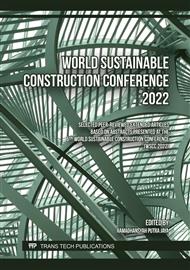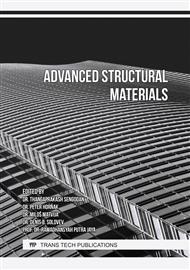[1]
Matori, K. A., Wah, L. C., Hashim, M., Ismail, I., and Zaid, M. H. M. (2012). Phase transformations of α-alumina made from waste aluminum via a precipitation technique. International journal of molecular sciences 13, 16812-16821.
DOI: 10.3390/ijms131216812
Google Scholar
[2]
Michel Devadoss, P.S.; Agamuthu, P.; Mehran, S.B.; Santha, C.; Fauziah, S.H. Implications of Municipal Solid Waste Management on Greenhouse Gas Emissions in Malaysia and the Way Forward. Waste Manag. 2021, 119, 135–144.
DOI: 10.1016/j.wasman.2020.09.038
Google Scholar
[3]
Goh, Y.G.; Sufian, A.S.; Mohamad, N.; Afiqah, N. Mechanical Properties of Recycled Polypropylene Filled with Aluminium Hydroxide. Mater. Sci. Forum 2020, 1010, 130–135.
DOI: 10.4028/www.scientific.net/msf.1010.130
Google Scholar
[4]
Umar, U.A.; Shafiq, N.; Ahmad, F.A. A Case Study on the Effective Implementation of the Reuse and Recycling of Construction & Demolition Waste Management Practices in Malaysia. Ain Shams Eng. J. 2021, 12, 283–291.
DOI: 10.1016/j.asej.2020.07.005
Google Scholar
[5]
Kumar, S., Kumar, R., and Bandopadhyay, A. (2006). Innovative methodologies for the utilisation of wastes from metallurgical and allied industries. Resources, Conservation and Recycling 48, 301-314.
DOI: 10.1016/j.resconrec.2006.03.003
Google Scholar
[6]
Liu, W., Niu, T., Yang, J., Wang, Y., Hu, S., Dong, Y., and Xu, H. (2011). Preparation of micron-sized alumina powders from aluminium beverage can by means of sol–gel process. Micro & Nano Letters 6, 852-854.
DOI: 10.1049/mnl.2011.0491
Google Scholar
[7]
Brough, D.; Jouhara, H. The Aluminium Industry: A Review on State-of-the-Art Technologies, Environmental Impacts and Possibilities forWaste Heat Recovery. Int. J. Thermofluids 2020, 1–2, 100007.
DOI: 10.1016/j.ijft.2019.100007
Google Scholar
[8]
Bashir, M.J.K.; Jun, Y.Z.; Yi, L.J.; Abushammala, M.F.M.; Amr, S.S.A.; Pratt, L.M. Appraisal of Student's Awareness and Practices on Waste Management and Recycling in the Malaysian University's Student Hostel Area. J. Mater. Cycles Waste Manag. 2020, 22, 916–927.
DOI: 10.1007/s10163-020-00988-6
Google Scholar
[9]
Bin Mokaizh, A.A.; Wirman, N.; Shariffuddin, J.H. Synthesis of Alumina from Aluminium Can Waste to Be Applied as Catalyst Support for Biodiesel Production. IOP Conf. Ser. Mater. Sci. Eng. 2019, 702, 012038.
DOI: 10.1088/1757-899x/702/1/012038
Google Scholar
[10]
Chotisuwan, S., Sirirak, A., Har-Wae, P., and Wittayakun, J. (2012). Mesoporous alumina prepared from waste aluminum cans and used as catalytic support for toluene oxidation. Materials Letters 70, 125-127
DOI: 10.1016/j.matlet.2011.11.077
Google Scholar
[11]
Verran, G., and Kurzawa, U. (2008). An experimental study of aluminum can recycling using fusion in induction furnace. Resources, Conservation and Recycling 52, 731-736.
DOI: 10.1016/j.resconrec.2007.10.001
Google Scholar
[12]
Adans, Y. F., Martins, A. R., Coelho, R. E., Das Virgens, C. F., Ballarini, A. D., and Carvalho, L. S. (2016a). A simple way to produce γ-Alumina from aluminum cans by precipitation reactions. Materials Research 19, 977-982.
DOI: 10.1590/1980-5373-mr-2016-0310
Google Scholar
[13]
Adans, Y. F., Martins, A. R., Coelho, R. E., Virgens, C. F. d., Ballarini, A. D., and Carvalho, L. S. (2016b). A Simple Way to Produce γ-Alumina From Aluminum Cans by Precipitation Reactions. Materials Research 19, 977-982.
DOI: 10.1590/1980-5373-mr-2016-0310
Google Scholar
[14]
Ahmedzeki, N. S., Hussein, S., & Abdulnabi, W. A. (2017). Recycling Waste Cans to Nano Gamma Alumina Effect of the Calcination Temperature and pH. International Journal of Current Engineering and Technology, 7(1), 81-88.
Google Scholar
[15]
Aswad, M. A. (2012). Residual Stress and Fracture in High Temperature Ceramics. Retrieved from https://www.escholar.manchester.ac.uk/jrul/item/?pid=ukac-man scw:157835.
Google Scholar
[16]
Glenn, K. (2016, June 25). Overview of Alumina. Retrieved from http://www.glennklockwood.com/materials-science/.
Google Scholar
[17]
Mert, H. H., & Mert, M. S. (2019). Preparation and characterization of encapsulated phase change materials in presence of gamma alumina for thermal energy storage applications. Thermochimica Acta, 681, 178382.
DOI: 10.1016/j.tca.2019.178382
Google Scholar
[18]
Bin Mokaizh, A.A.; Shariffuddin, J.H.B.H. Synthesis of -Alumina Developed from Waste Aluminium Using Precipitation Technique. J. Phys. Conf. Ser. 2021, 1900, 012002.
DOI: 10.1088/1742-6596/1900/1/012002
Google Scholar
[19]
Osman, A. Abu-Dahrieh, J. & Rooney. D. (2015). Novel acid catalyst for thedehydration of methanol to dimethyl ether.
Google Scholar
[20]
Abdelkader, A., Osman, A. I., Halawy, S. A., & Mohamed, M. A. (2018). Preparation and characterization of mesoporous γ-Al2O3 recovered from aluminum cans waste and its use in the dehydration of ethanol to dimethyl ether. Journal of Material Cycles and Waste Management, 20(3), 1428-1436.
DOI: 10.1007/s10163-018-0702-0
Google Scholar
[21]
Kononchuk, O., Alekseev, A., Zubkova, O., & Udovitsky, V. (2017). Scientific Background for Processing of Aluminum Waste. In E3S Web of Conferences (Vol. 21, p.02003).
DOI: 10.1051/e3sconf/20172102003
Google Scholar
[22]
Omer, A.H.; Bin Mokaizh, A.A.; Shariffuddin, J.H.B.H. Low-Calcination Temperature to Synthesize A-Alumina From Aluminium Waste Can Using Sol-Gel Method. IOP Conf. Ser. Earth Environ. Sci. 2021, 641, 012023.
DOI: 10.1088/1755-1315/641/1/012023
Google Scholar
[23]
Bin Mokaizh, A. A., Shariffuddin, J. H., Baarimah, A. O., Al-Fakih, A., Mohamed, A., Baarimah, S. O., ... & Saeed, A. A. H. (2022). Elucidating the Effects of Reaction Time on the Physicochemical Characterization of Valorized Synthesized Alumina. Materials, 15(9), 3046.
DOI: 10.3390/ma15093046
Google Scholar
[24]
Bin Mokaizh, A. A., Al Haiqi, O., & Shariffuddin, J. H. B. H. (2021). Investigating the effects of calcination time on Α-alumina synthesis from aluminum waste can. Physics and Chemistry of the Earth, Parts A/B/C, 122, 102979.
DOI: 10.1016/j.pce.2021.102979
Google Scholar
[25]
Bin Mokaizh, A. A., & Shariffuddin, J. H. B. H. (2021). Manufacturing of Nanoalumina by Recycling of Aluminium Cans Waste. In Waste Recycling Technologies for Nanomaterials Manufacturing (pp.851-870). Springer, Cham.
DOI: 10.1007/978-3-030-68031-2_30
Google Scholar
[26]
Asencios, Y. J., and Sun-Kou, M. R. (2012). Synthesis of high-surface-area γ-Al 2 O 3 from aluminum scrap and its use for the adsorption of metals: Pb (II), Cd (II) and Zn (II). Applied Surface Science 258, 10002-10011.
DOI: 10.1016/j.apsusc.2012.06.063
Google Scholar
[27]
Vargas-Martínez, N., Ruíz-Baltazar, Á. D. J., Medellín-Castillo, N. A., & Reyes-López, S. Y. (2018). Synthesis of α-Alumina Nano-Onions by Thermal Decomposition of Aluminum Formate. Journal of Nanomaterials, 2018.
DOI: 10.1155/2018/9061378
Google Scholar
[28]
AlSairafi, S. H., AlNajdi, N., AlSheeha, H., & Rana, M. S. (2020). Synthesis of alumina support and effect of its properties on thiophene hydrodesulfurization. Reaction Kinetics, Mechanisms and Catalysis, 129(1), 297-313.
DOI: 10.1007/s11144-019-01706-6
Google Scholar
[29]
Ouyang,, Y., Li, X., Ding, F., Bai, L., & Yuan, F. (2020). Simultaneously enhance thermal conductive property and mechanical properties of silicon rubber composites by introducing ultrafine Al2O3 nanospheres prepared via thermal plasma. Composites Science and Technology, 190, 108019.
DOI: 10.1016/j.compscitech.2020.108019
Google Scholar
[30]
Sheel, T. K., Poddar, P., Murad, A. W., Neger, A. T., & Chowdhury, A. S. (2016). Preparation of Aluminum Oxide from Industrial Waste Can Available in Bangladesh 10 Environment: SEM and EDX Analysis. Journal of Advanced Chemical Engineering, 06(02).
DOI: 10.4172/2090-4568.1000152
Google Scholar
[31]
Wu, Y., Ma, J., Hu, F., and Li, M. (2012). Synthesis and characterization of mesoporous alumina via a reverse precipitation method. Journal of Materials Science & Technology 28, 572-576.
DOI: 10.1016/s1005-0302(12)60100-5
Google Scholar
[32]
Xu, N., Liu, Z., Bian, S., Dong, Y., and Li, W. (2016). Template-free synthesis of mesoporous γ-alumina with tunable structural properties. Ceramics International 42, 072- 4079.
DOI: 10.1016/j.ceramint.2015.11.079
Google Scholar



